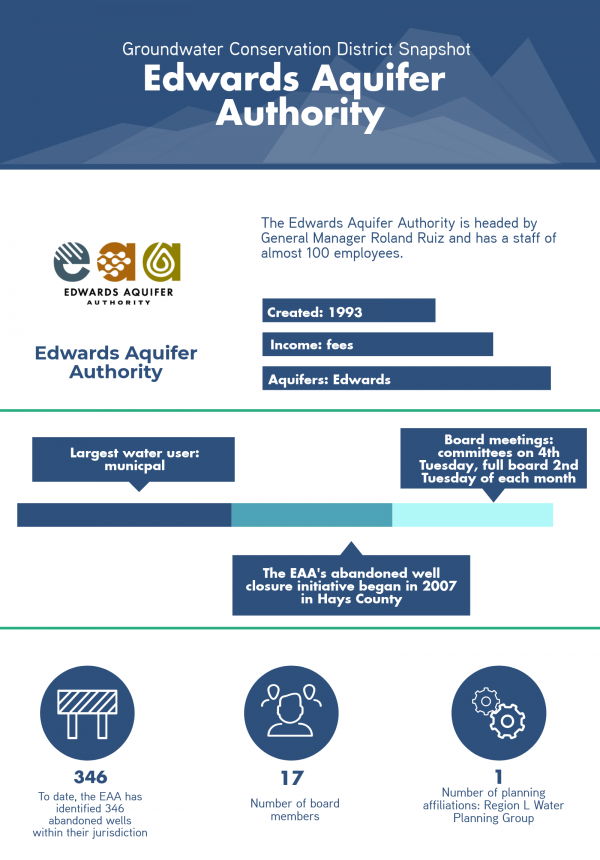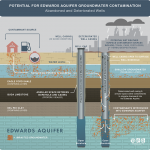Edwards Aquifer Authority

Abandoned wells are an ongoing groundwater management issue for Groundwater Conservation Districts (GCDs). In response, many GCDs have developed abandoned well programs. We sat down with the Edwards Aquifer Authority (EAA) to learn more about their abandoned well program and abandoned well closure initiative.
TAGD: When was the program established?
EAA: The EAA’s abandoned well closure initiative began in 2007 in Hays County. The effort then moved into Comal County in 2013 and Bexar County in 2018. Efforts will focus on Medina and Uvalde counties when the Bexar County effort is substantially completed.
TAGD: Tell us about the program?
EAA: The EAA initiated a groundwater protection initiative in 2007 to locate, confirm use, and assess the condition of all Edwards Aquifer wells within the EAA’s jurisdiction. The initiative concentrates well research and canvassing efforts in a systematic, county-wide approach. Well research involves reviewing historical EAA records, state groundwater well logs and historical photography. Well canvassing includes site visits and conversations with well owners to confirm use and assess the condition of the well. Although the vast majority of wells are active and in good condition, this process helps identify which wells might be abandoned and/or deteriorated.
To date, EAA staff has identified approximately 346 abandoned wells within the EAA’s jurisdictional  boundary. Once the condition of the well is determined, staff can then chart a proper course of remediation including capping or plugging the well. Unfortunately, being that it is the responsibility of the well owner to rectify their well status, and the solution can cost anywhere from several thousand to tens of thousands of dollars, the well often goes unaddressed
boundary. Once the condition of the well is determined, staff can then chart a proper course of remediation including capping or plugging the well. Unfortunately, being that it is the responsibility of the well owner to rectify their well status, and the solution can cost anywhere from several thousand to tens of thousands of dollars, the well often goes unaddressed
TAGD: What was the impetus for the program?
EAA: Through the normal course of changing land use, and in some cases the expansion of municipal water distribution systems, many groundwater wells become abandoned or deteriorated without being properly plugged. An abandoned well is a well that is not physically or legally capable of making beneficial groundwater withdrawals; whereas a deteriorated well is an active or abandoned well that, due to its condition, may allow polluted surface runoff or shallow groundwater to enter the well. Either of these categories can result in wells serving as direct conduits for pollutants to contaminate the aquifer. These types of wells create a potential health risk to the groundwater supply as an abandoned well is a direct conduit from the surface to the aquifer below.
TAGD: What is the goal of the program?
The long-term goal of this program would be the identification, registration and proper closure of all abandoned wells within the EAA’s jurisdiction.
TAGD: What resources are available for landowners?
EAA: EAA staff can guide owners through the process of identifying and, if necessary, properly closing a well. There are two basic ways to stop the threat of contamination. A well can be capped if there are plans for using it in the future, or it can be plugged and sealed permanently. Programs are available for those who need financial assistance to cap or plug abandoned wells. The EAA currently has funded a needs-based abandoned well closure assistance program (AWCAP) to assist well owners with proper plugging of wells. Additionally, the EAA may provide services such as camera work to help determine the condition of a well
For more information regarding the EAA and their abandoned well program, please visit www.edwardsaquifer.org.
To learn more about plugging abandoned wells, visit TCEQ’s Texas Groundwater Protection Committee’s landowners guide on plugging abandoned wells here.
To find out which GCD you are in, please visit TAGD’s Groundwater Conservation District Index here.
